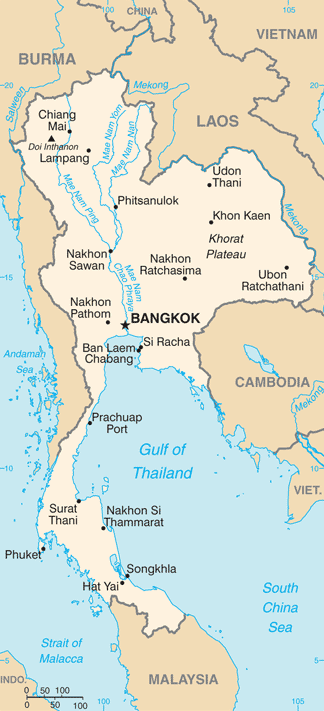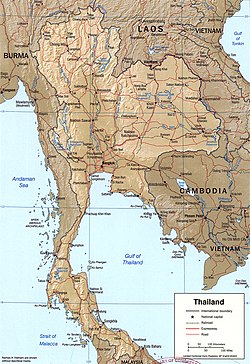Geography of Thailand

Thailand's 514,000 square kilometers lie in the middle of mainland Southeast Asia. The nation's axial position influenced many aspects of Thailand's society and culture—it controls the only land route from Asia to Malaysia and Singapore.
Geographic coordinates
History
The earliest speakers of the Tai language migrated from what is now China, following rivers into northern Thailand and southward to the Mekong and the Chao Phraya Valley.
The fertile floodplain and tropical monsoon climate, ideally suited to wet-rice (thamna) cultivation, attracted settlers to this central area rather than to the marginal uplands and mountains of the northern region or the Khorat Plateau to the northeast.
By the 12th century, a number of loosely connected rice-growing and trading states flourished in the upper Chao Phraya Valley. Starting in the middle of the 14th century, these central chiefdoms gradually came under the control of the Ayutthaya kingdom at the southern extremity of the floodplain.
Successive capitals, built at various points along the river, became centers of great Thai kingdoms based on rice cultivation and foreign commerce. Unlike the neighboring Khmer and Burmese, the Thai continued to look outward across the Gulf of Thailand and the Andaman Sea toward foreign ports of trade.
When European imperialism brought a new phase in Southeast Asian commerce in the late 1800s, Thailand (known then as Siam) was able to maintain its independence as a buffer zone between British-controlled Burma to the west and French-dominated Indochina to the east.
Boundaries
Land boundaries
Coastline
- Total: 3 219 km
Maritime claims
- territorial sea: 12 nm
- exclusive economic zone: 200 nm
- continental shelf: 200-m depth or to the depth of exploitation
Border issues
History
Thailand shares boundaries with Cambodia, Laos, Malaysia and Myanmar. Although neither China nor Vietnam border Thailand, the territory of both countries comes within 100 km of Thai territory.
Many parts of Thailand's boundaries followed natural features, such as the Mekong. Most borders had been stabilized and demarcated in the late 19th and early 20th centuries in accordance with treaties forced on Thailand and its neighbors by Britain and France. In some areas, however, exact boundaries, especially along Thailand's eastern borders with Laos and Cambodia, are still in dispute.
Adding to general border tensions were the activities of communist-led insurgents, whose operations had been of paramount concern to the Thai government and its security forces for several decades. The problem of communist insurgency was compounded by the activity of what the Thai government labeled "antistate elements." Often the real source of border problems was ordinary criminals or local merchants involved in illegal mining, logging, smuggling, and narcotics production and trade.
Cambodia
Disputes with Cambodia after 1950 arose in part from ill-defined boundaries. The most notable case was a dispute over Prasat Preah Vihear submitted to the International Court of Justice, which ruled in favor of Cambodia in 1962. During the years that the Cambodian capital, Phnom Penh, was controlled by the Khmer Rouge regime of Pol Pot (1975 to 1979), the border disputes continued.
In the early 1980s, the People's Republic of Kampuchea and its mentor, Vietnam, made an issue of boundaries in Prachin Buri Province in eastern Thailand.
The Preah Vihear temple remains a source of contention, with Cambodia accusing Thailand of moving boundary markers and obstructing access to the temple ruins, and Thailand, for its part, accusing Cambodia of polluting the waterways that run through the area and into Thailand.
Cambodian casinos along the frontier and various cross-border criminal activities are also a security concern.
Laos
Demarcation with Laos is complete except for certain Mekong islets and complaints of Thai squatters.
Malaysia
In contrast to dealings with Cambodia, which attracted international attention, boundary disputes with Malaysia (see Malaysia-Thailand Border) are usually handled more cooperatively. Continuing mineral exploration and fishing, however, are sources of potential conflict. A 1 km segment at the mouth of the Golok River remained in dispute with Malaysia as of 2004.
Myanmar
Significant differences remain with Myanmar over boundary alignment and the handling of ethnic rebels, refugees and illegal drug trade, in addition to mineral exploration and fishing rights. Groups in both countries have expressed concern over the Peoples Republic of China's construction of 13 hydroelectric dams on the Salween River in Yunnan.
Area
- Total: 514 000 km²
- Land: 511 770 km²
- Water: 2 230 km²
Thailand uses a unit of land area called the rai, which is 1 600 m².
Topography and drainage


The most conspicuous features of Thailand's terrain are high mountains, a central plain, and an upland plateau. Mountains cover much of northern Thailand and extend along the Myanmar border down through the Kra Isthmus and the Malay Peninsula. The central plain is a lowland area drained by the Chao Phraya River and its tributaries, the country's principal river system, which feeds into the delta at the head of the Bay of Bangkok. The Chao Phraya system drains about one-third of the nation's territory. In the northeastern part of the country the Khorat Plateau, a region of gently rolling low hills and shallow lakes, drains into the Mekong through the Mun River. The Mekong system empties into the South China Sea and includes a series of canals and dams.
Together, the Chao Phraya and Mekong systems sustain Thailand's agricultural economy by supporting wet-rice cultivation and providing waterways for the transport of goods and people. In contrast, the distinguishing natural features of peninsular Thailand are long coastlines, offshore islands, and diminishing mangrove swamps.
Elevation extremes
- Lowest point: Gulf of Thailand 0 m
- Highest point: Doi Inthanon 2,576 m
Regions
Landforms and drainage divide the country more or less into four natural regions--the North, the Northeast, Central, and the South. Although Bangkok geographically is part of the central plain, as the capital and largest city this metropolitan area may be considered in other respects a separate region. Each of the four geographical regions differs from the others in population, basic resources, natural features, and level of social and economic development. The diversity of the regions is in fact the most pronounced attribute of Thailand's physical setting.
North Thailand
During the winter months in the mountainous North, the temperature is cool enough for the cultivation of fruits such as lychees and strawberries. These high mountains are incised by steep river valleys and upland areas that border the central plain. A series of rivers, including the Nan, Ping, Wang, and Yom, unite in the lowlands to form the Chao Phraya watershed. Traditionally, these natural features made possible several different types of agriculture, including wet-rice farming in the valleys and shifting cultivation in the uplands. The forested mountains also promoted a spirit of regional independence. Forests, including stands of teak and other economically useful hardwoods that once dominated the North and parts of the Northeast, had diminished by the 1980s to 130,000 km². In 1961 they covered 56 % of the country, but by the mid-1980s forestland had been reduced to less than 30 % of Thailand's total area.
Northeast
The Northeast, with its poor soils, is not favored agriculturally. The region consists mainly of the dry Khorat Plateau and a few low hills. The short monsoon season brings heavy flooding in the river valleys. Unlike the more fertile areas of Thailand, the Northeast has a long dry season, and much of the land is covered by sparse grasses. Mountains ring the plateau on the west and the south, and the Mekong delineates much of the eastern rim.
Central Thailand
The "heartland", Central Thailand, is a natural self-contained basin often termed "the rice bowl of Asia." The complex irrigation system developed for wet-rice agriculture in this region provided the necessary economic support to sustain the development of the Thai state from the 13th century Sukhothai kingdom to contemporary Bangkok. Here the rather flat unchanging landscape facilitated inland water and road transport. The fertile area was able to sustain a dense population, 422 persons per square kilometer in 1987, compared with an average of 98 for the country as a whole. The terrain of the region is dominated by the Chao Phraya and its tributaries and by the cultivated paddy fields. Metropolitan Bangkok, the focal point of trade, transport, and industrial activity, is situated on the southern edge of the region at the head of the Gulf of Thailand and includes part of the delta of the Chao Phraya system.
South Thailand
The South, a narrow peninsula, is distinctive in climate, terrain, and resources. Its economy is based on rice cultivation for subsistence and rubber production for industry. Other sources of income include coconut plantations, tin mining, and tourism, which is particularly lucrative on Phuket Island. Rolling and mountainous terrain and the absence of large rivers are conspicuous features of the South. North-south mountain barriers and impenetrable tropical forest caused the early isolation and separate political development of this region. International access through the Andaman Sea and the Gulf of Thailand made the South a crossroads for both Theravada Buddhism, centered at Nakhon Si Thammarat, and Islam, especially in the former Pattani kingdom on the border with Malaysia.
Provinces
Thailand's regions are further divided into a total of 73 provinces. The country's provinces have the same names as their respective capitals.
Climate

Thailand has a tropical monsoon climate; temperatures normally range from an average annual high of 38 °C to a low of 19 °C. Southwest monsoons that arrive between May and July (except in the South) signal the advent of the rainy season (ridu fon), which lasts into October. November and December mark the onset of the dry season. Temperatures begin to climb in January, and a hot sun parches the landscape. The dry season is shortest in the South because of the proximity of the sea to all parts of the Malay Peninsula. With only minor exceptions, every area of the country receives adequate rainfall, but the duration of the rainy season and the amount of rain vary substantially from region to region and with altitude. The Northeast experiences a long dry season, and its red, porous (laterite) soils retain water poorly, which limits their agricultural potential.
Resources and land use
Natural resources
- Tin, rubber, natural gas, tungsten, tantalum, timber, lead, fish, gypsum, lignite, fluorite, arable land, wheat
Land use
- Arable land: 34%
- Permanent crops: 6%
- Permanent pastures: 2%
- Forests and woodland: 26%
- Other: 32% (1993 est.)
Irrigated land
- Total: 44,000 km² (1993 est.)
Environmental concerns
Natural hazards
Land subsidence in Bangkok area resulting from the depletion of the water table; droughts (see also 2004 Indian Ocean earthquake).
Current environmental issues
- Air pollution from vehicle emissions
- Water pollution from organic and factory wastes
- Deforestation
- Soil erosion
- Wildlife populations threatened by illegal hunting
International environmental agreements
- Party to: Climate Change, Endangered Species, Hazardous Wastes, Marine Life Conservation, Nuclear Test Ban, Ozone layer protection, Tropical Timber 83, Tropical Timber 94, Wetlands
- Signed, but not ratified: Biodiversity, Climate Change (Kyoto Protocol), Law of the Sea
See also
References

This image is available from the United States Library of Congress Prints and Photographs Division under the digital ID {{{id}}}
This tag does not indicate the copyright status of the attached work. A normal copyright tag is still required. See Wikipedia:Copyrights for more information.
 This article incorporates public domain material from The World Factbook. CIA.
This article incorporates public domain material from The World Factbook. CIA.
